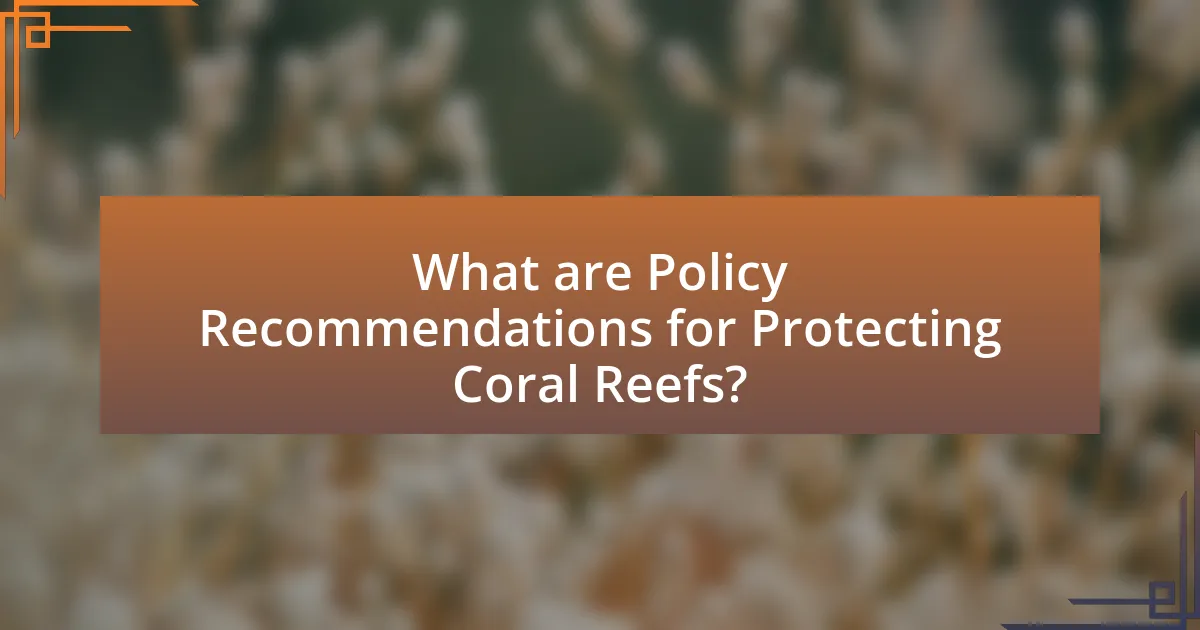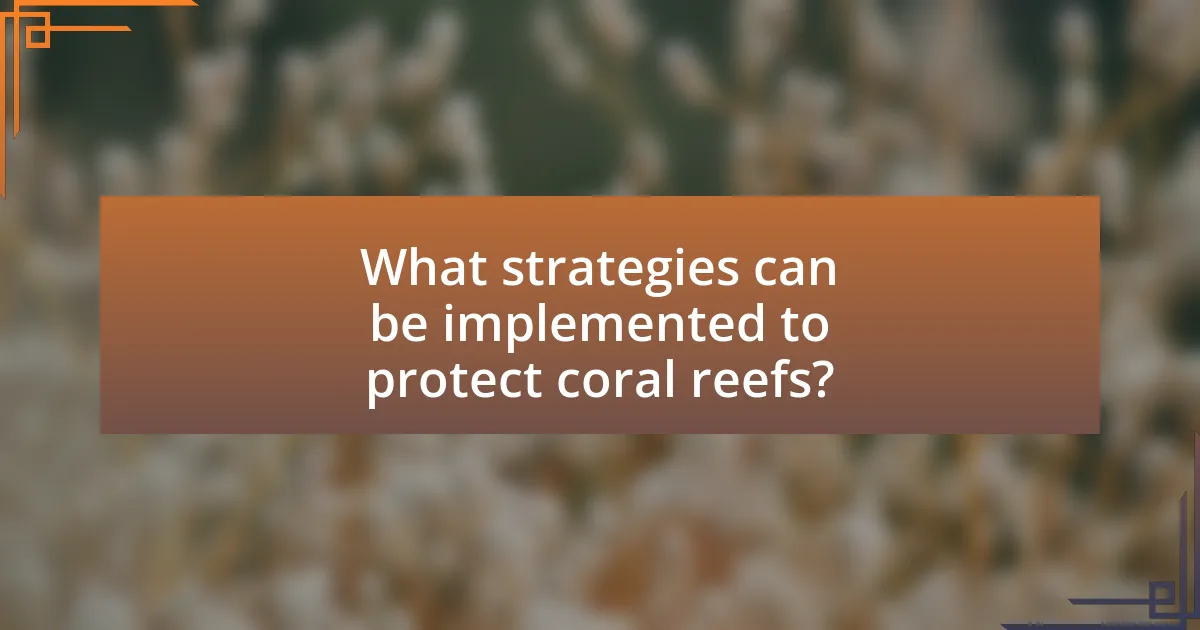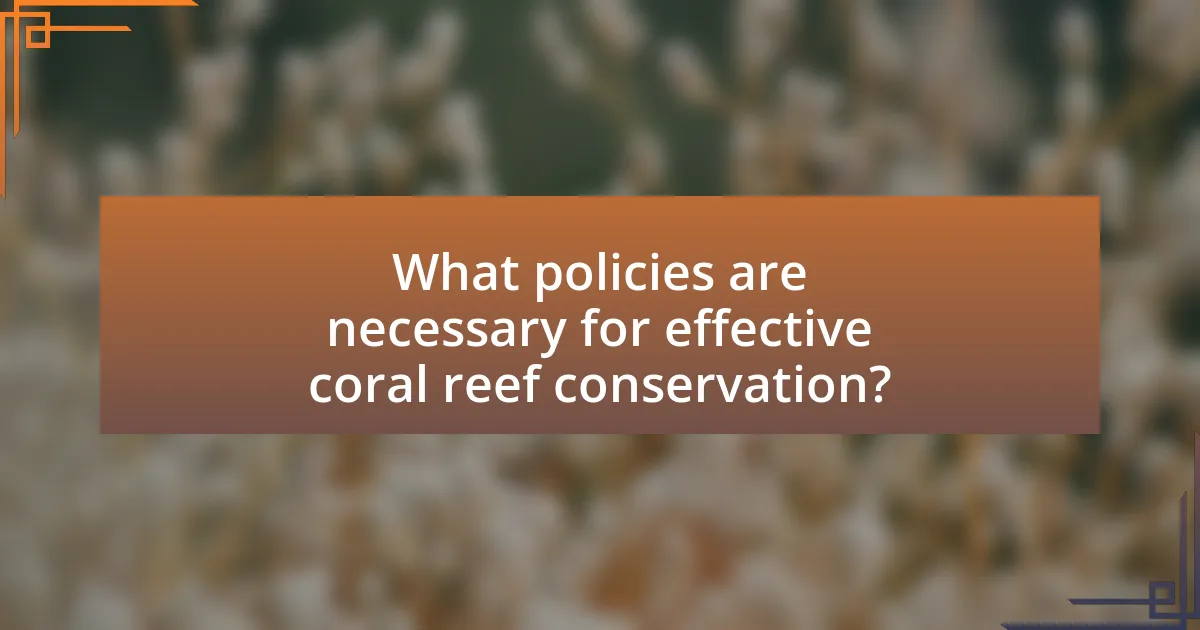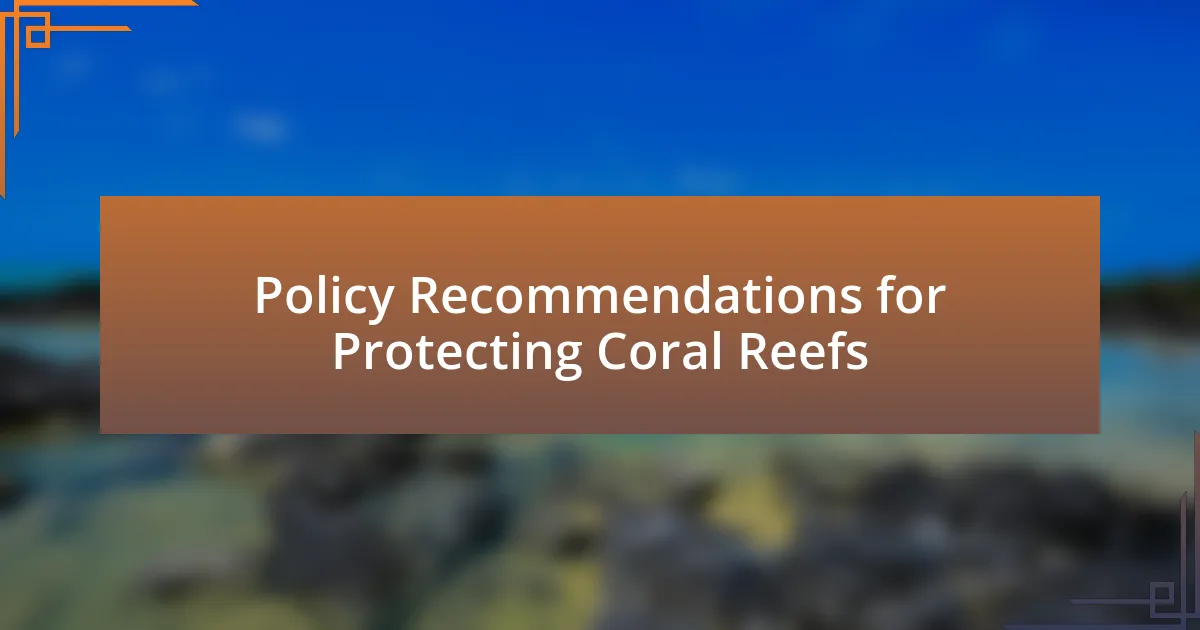The article focuses on policy recommendations for protecting coral reefs, emphasizing the importance of establishing marine protected areas (MPAs), implementing sustainable fishing practices, and reducing carbon emissions. Coral reefs are vital to marine ecosystems, supporting a significant portion of marine biodiversity and providing essential coastal protection. The article outlines the main threats to coral reefs, including climate change, overfishing, pollution, and coastal development, and discusses strategies for effective conservation, such as community engagement and international cooperation. It highlights the critical role of sustainable fishing and pollution control in maintaining coral health and resilience, ultimately aiming to enhance the long-term sustainability of these ecosystems.

What are Policy Recommendations for Protecting Coral Reefs?
Policy recommendations for protecting coral reefs include establishing marine protected areas (MPAs), implementing sustainable fishing practices, and reducing carbon emissions. MPAs help conserve biodiversity and allow ecosystems to recover by restricting harmful activities. Sustainable fishing practices, such as catch limits and gear restrictions, prevent overfishing and habitat destruction. Reducing carbon emissions addresses climate change, which is a significant threat to coral health, as rising temperatures and ocean acidification lead to coral bleaching. According to the Global Coral Reef Monitoring Network, effective management of these strategies can significantly enhance coral resilience and recovery.
Why are coral reefs important to marine ecosystems?
Coral reefs are crucial to marine ecosystems because they provide habitat, food, and breeding grounds for a diverse array of marine species. These ecosystems support approximately 25% of all marine life, despite covering less than 1% of the ocean floor. Coral reefs also play a significant role in protecting coastlines from erosion and storm damage, acting as natural barriers. Furthermore, they contribute to the economy through fisheries and tourism, with an estimated value of over $375 billion annually. The loss of coral reefs would lead to a decline in biodiversity and negatively impact the livelihoods of millions of people who depend on these ecosystems.
What roles do coral reefs play in biodiversity?
Coral reefs play a crucial role in biodiversity by providing habitat, food, and breeding grounds for a vast array of marine species. These ecosystems support approximately 25% of all marine life despite covering less than 1% of the ocean floor, demonstrating their significance in maintaining ecological balance. The complex structures of coral reefs create niches for various organisms, from fish to invertebrates, fostering high levels of species richness and endemism. Additionally, coral reefs contribute to the overall health of ocean ecosystems by supporting food webs and nutrient cycling, which are essential for sustaining marine biodiversity.
How do coral reefs contribute to coastal protection?
Coral reefs contribute to coastal protection by acting as natural barriers that absorb wave energy, reducing the impact of storms and erosion on shorelines. This protective function is crucial, as studies indicate that coral reefs can decrease wave height by up to 97%, significantly mitigating coastal flooding and property damage during extreme weather events. Additionally, healthy coral reefs support biodiversity, which enhances ecosystem resilience, further bolstering their role in safeguarding coastal areas.
What are the main threats to coral reefs?
The main threats to coral reefs include climate change, overfishing, pollution, and coastal development. Climate change leads to ocean warming and acidification, which can cause coral bleaching and mortality; studies indicate that increased sea temperatures have resulted in widespread coral bleaching events, affecting approximately 75% of the world’s coral reefs. Overfishing disrupts the balance of marine ecosystems, as the removal of key species can lead to algal overgrowth that smothers corals. Pollution from agricultural runoff, plastics, and sewage introduces harmful substances into marine environments, degrading water quality and harming coral health. Coastal development, including construction and tourism, often results in habitat destruction and increased sedimentation, which can suffocate corals and reduce their ability to thrive.
How does climate change impact coral reefs?
Climate change significantly impacts coral reefs primarily through rising sea temperatures and ocean acidification. Elevated sea temperatures lead to coral bleaching, a phenomenon where corals expel the symbiotic algae living in their tissues, resulting in loss of color and essential nutrients. Studies indicate that a temperature increase of just 1-2 degrees Celsius can trigger widespread bleaching events, threatening coral survival. Additionally, ocean acidification, caused by increased carbon dioxide absorption, reduces the availability of carbonate ions necessary for coral calcification, weakening their structures. Research published in “Nature Climate Change” by Hughes et al. (2017) highlights that these stressors can lead to a decline in coral cover and biodiversity, ultimately disrupting marine ecosystems and the livelihoods of communities dependent on them.
What effects do pollution and overfishing have on coral reefs?
Pollution and overfishing significantly harm coral reefs by degrading their health and biodiversity. Pollution introduces harmful substances, such as nutrients and toxins, which can lead to algal blooms that suffocate corals and disrupt their symbiotic relationships with zooxanthellae, essential for coral survival. Overfishing removes key species that maintain the ecological balance, such as herbivorous fish that control algae growth, further exacerbating the decline of coral health. Studies indicate that areas with high nutrient pollution can experience up to a 50% reduction in coral cover, while overfishing can lead to a 90% decline in certain fish populations crucial for reef resilience.

What strategies can be implemented to protect coral reefs?
To protect coral reefs, strategies such as establishing marine protected areas (MPAs), regulating fishing practices, and reducing pollution can be implemented. Marine protected areas help conserve biodiversity by restricting harmful activities, with studies showing that MPAs can lead to a 20-50% increase in fish biomass within their boundaries. Regulating fishing practices, including the use of sustainable fishing gear and enforcing catch limits, prevents overfishing and allows coral ecosystems to recover. Additionally, reducing pollution from land-based sources, such as agricultural runoff and plastic waste, is crucial, as research indicates that nutrient pollution can lead to harmful algal blooms that suffocate coral reefs. These strategies collectively contribute to the resilience and health of coral reef ecosystems.
How can marine protected areas (MPAs) help coral reefs?
Marine protected areas (MPAs) can significantly benefit coral reefs by providing a refuge from human activities such as overfishing and pollution. MPAs restrict harmful practices, allowing coral ecosystems to recover and thrive. Research indicates that MPAs can lead to increased fish populations and biodiversity, which are crucial for maintaining healthy coral reef systems. For instance, a study published in “Nature” by Edgar et al. (2014) found that fully protected MPAs can increase fish biomass by an average of 446% compared to unprotected areas. This enhanced biodiversity supports the resilience of coral reefs against climate change and other stressors.
What are the criteria for establishing effective MPAs?
Effective Marine Protected Areas (MPAs) are established based on several key criteria: clear objectives, adequate size, appropriate location, effective management, and stakeholder involvement. Clear objectives define the specific conservation goals, such as protecting biodiversity or enhancing fish stocks. Adequate size ensures that the MPA encompasses sufficient habitat to support the targeted species and ecosystems, with studies indicating that larger MPAs are generally more effective in achieving conservation outcomes. Appropriate location involves selecting areas that are critical for the life cycles of marine species, often based on ecological data. Effective management includes enforcement of regulations and ongoing monitoring to assess the MPA’s health and effectiveness. Finally, stakeholder involvement ensures that local communities and relevant stakeholders are engaged in the decision-making process, which has been shown to enhance compliance and support for conservation efforts.
How do MPAs benefit local communities?
Marine Protected Areas (MPAs) benefit local communities by enhancing fish populations and biodiversity, which directly supports local fisheries and tourism. Research indicates that MPAs can lead to a 20-30% increase in fish biomass within their boundaries, resulting in more sustainable fishing yields for local communities. Additionally, MPAs contribute to ecosystem resilience, helping to protect coastal areas from climate change impacts, which is crucial for communities reliant on marine resources. The establishment of MPAs has been shown to create job opportunities in eco-tourism and conservation efforts, further supporting local economies.
What role does sustainable fishing play in coral reef protection?
Sustainable fishing plays a crucial role in coral reef protection by ensuring that fish populations remain healthy and ecosystems are balanced. Overfishing can lead to the depletion of key species that maintain the ecological integrity of coral reefs, such as herbivorous fish that control algae growth. Research indicates that areas practicing sustainable fishing show greater biodiversity and resilience in coral reef ecosystems, as evidenced by a study published in the journal “Marine Ecology Progress Series,” which found that sustainable practices can enhance fish biomass and diversity, ultimately benefiting coral health.
What practices can promote sustainable fishing near coral reefs?
Sustainable fishing near coral reefs can be promoted through practices such as implementing marine protected areas (MPAs), using selective fishing gear, and enforcing catch limits. Marine protected areas help conserve fish populations and habitats, as evidenced by a study published in the journal “Conservation Biology,” which found that MPAs can lead to a 20-50% increase in fish biomass. Selective fishing gear reduces bycatch and minimizes damage to coral ecosystems, while enforcing catch limits ensures that fish populations remain sustainable, preventing overfishing. These practices collectively contribute to the health of coral reef ecosystems and the livelihoods of communities that depend on them.
How can fisheries management be improved to protect coral ecosystems?
Fisheries management can be improved to protect coral ecosystems by implementing sustainable fishing practices, establishing marine protected areas (MPAs), and enforcing stricter regulations on fishing quotas. Sustainable fishing practices, such as selective gear use and seasonal closures, reduce bycatch and allow fish populations to recover, which is crucial for maintaining coral health. The establishment of MPAs has been shown to enhance biodiversity and resilience of coral reefs; for instance, a study published in “Marine Ecology Progress Series” found that MPAs can lead to a 20-50% increase in fish biomass. Additionally, enforcing stricter regulations on fishing quotas helps prevent overfishing, which directly impacts coral ecosystems by disrupting the balance of marine life. These strategies collectively contribute to the long-term sustainability of coral reefs.

What policies are necessary for effective coral reef conservation?
Effective coral reef conservation requires policies that include the establishment of marine protected areas (MPAs), sustainable fishing practices, and pollution control measures. Marine protected areas help to safeguard critical habitats by restricting harmful activities, which has been shown to enhance biodiversity and ecosystem resilience. For instance, a study published in “Nature” by Edgar et al. (2014) found that MPAs can lead to a 446% increase in fish biomass compared to unprotected areas. Sustainable fishing practices, such as catch limits and gear restrictions, are essential to prevent overfishing and ensure the long-term viability of fish populations that rely on coral reefs. Additionally, pollution control measures targeting land-based sources of pollution, such as agricultural runoff and plastic waste, are crucial, as these pollutants can severely degrade coral health. The United Nations Environment Programme emphasizes that reducing nutrient loading from agriculture can significantly improve coral reef resilience. Together, these policies create a comprehensive framework for effective coral reef conservation.
How can governments enforce regulations to protect coral reefs?
Governments can enforce regulations to protect coral reefs by implementing strict legal frameworks that prohibit harmful activities such as overfishing, coastal development, and pollution. For instance, the establishment of marine protected areas (MPAs) has been shown to significantly enhance coral reef resilience, as evidenced by a study published in the journal “Nature” which found that MPAs can lead to a 20-50% increase in fish biomass, thereby supporting healthier reef ecosystems. Additionally, governments can employ monitoring and enforcement mechanisms, such as satellite surveillance and on-site inspections, to ensure compliance with these regulations, as demonstrated by successful programs in countries like Australia, where the Great Barrier Reef Marine Park Authority actively monitors reef health and enforces fishing regulations.
What are the key components of effective coral reef policies?
Effective coral reef policies include stakeholder engagement, scientific research, sustainable management practices, and enforcement mechanisms. Stakeholder engagement ensures that local communities, governments, and organizations collaborate in decision-making, which is crucial for the success of conservation efforts. Scientific research provides the necessary data to inform policies, enabling adaptive management based on the latest findings about coral health and ecosystem dynamics. Sustainable management practices, such as regulating fishing and tourism, help maintain the ecological balance of coral reefs. Finally, enforcement mechanisms are essential to ensure compliance with regulations, as evidenced by studies showing that well-enforced policies lead to healthier reef ecosystems.
How can international cooperation enhance coral reef protection?
International cooperation can enhance coral reef protection by facilitating the sharing of resources, knowledge, and best practices among countries. Collaborative efforts, such as the Coral Triangle Initiative, demonstrate how nations can work together to implement sustainable management practices, enforce regulations, and conduct joint research. For instance, the Global Coral Reef Monitoring Network provides data that helps countries assess the health of their reefs and develop targeted conservation strategies. By pooling financial resources and expertise, international partnerships can also support large-scale restoration projects and increase resilience against climate change impacts, ultimately leading to more effective coral reef conservation.
What community-based initiatives can support coral reef conservation?
Community-based initiatives that can support coral reef conservation include local stewardship programs, community-led monitoring efforts, and educational outreach initiatives. Local stewardship programs empower communities to manage and protect their nearby reefs, often resulting in improved reef health and biodiversity. Community-led monitoring efforts involve local fishers and residents in data collection, which enhances scientific understanding and fosters a sense of ownership over the reefs. Educational outreach initiatives raise awareness about the importance of coral reefs and promote sustainable practices among community members. Evidence shows that such initiatives can lead to significant improvements in coral reef resilience, as demonstrated by successful programs in places like the Caribbean and the Great Barrier Reef, where local engagement has directly correlated with enhanced conservation outcomes.
How can local stakeholders be engaged in coral reef protection efforts?
Local stakeholders can be engaged in coral reef protection efforts through participatory management practices that involve them in decision-making processes. This engagement can include establishing community-based organizations that focus on coral reef conservation, facilitating workshops to educate stakeholders about the ecological and economic importance of reefs, and creating incentive programs that reward sustainable practices. Research indicates that when local communities are actively involved, such as in the case of the Coral Triangle Initiative, there is a significant increase in compliance with conservation measures and improved reef health.
What educational programs can raise awareness about coral reef issues?
Educational programs that can raise awareness about coral reef issues include community workshops, school curricula focused on marine biology, and online courses offered by environmental organizations. Community workshops often engage local populations in hands-on activities that highlight the importance of coral reefs and the threats they face, such as climate change and pollution. School curricula that incorporate marine biology educate students about coral ecosystems, fostering a sense of stewardship from a young age. Online courses, such as those provided by organizations like the Ocean Conservancy, offer accessible information on coral reef conservation and the impact of human activities, reaching a broader audience. These programs are effective in disseminating knowledge and encouraging proactive measures to protect coral reefs.
What are best practices for implementing coral reef protection policies?
Best practices for implementing coral reef protection policies include establishing marine protected areas (MPAs), enforcing sustainable fishing practices, and promoting community engagement in conservation efforts. MPAs have been shown to enhance biodiversity and fish populations, as evidenced by a study published in “Nature” which found that fully protected areas can increase fish biomass by up to 600%. Enforcing sustainable fishing practices, such as catch limits and gear restrictions, helps prevent overfishing and habitat destruction, contributing to healthier reef ecosystems. Additionally, involving local communities in decision-making processes fosters stewardship and compliance, as demonstrated by successful initiatives in the Caribbean where local engagement led to improved reef health and resilience.
